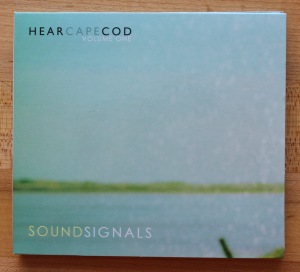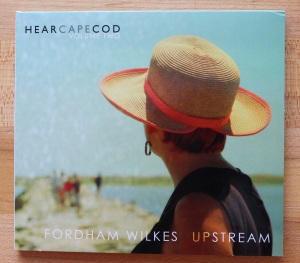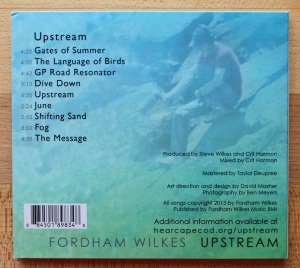Review: HearCapeCod – SoundSignals and Upstream
Volume One – SoundSignals – #HCC001
Notes and Detailed Credits: http://hearcapecod.org/soundsignals/
CD 1 (Time: 39:08): Sound Signals: Act 1: On Land, Act II: On Water, Act III: A Year, Coda: Route Six
CD 2 (Time: 46:24): Signals Remixed: 1: Goldmund, 2: Marcus Fischer, 3: Loscil, 4: Taylor Deupree, 5: Neara Russell, 6: FourColor, 7: Steve Wilkes, 8: Simon Scott, 9: FourColor & SoundSignal
Volume Two – Upstream by Fordham Wilkes – #HCC002
Notes and Detailed Credits: http://hearcapecod.org/upstream/
CD (Time: 37:08): 1) Gates of Summer, 2: The Language of Birds, 3: GP Road Resonator, 4: Dive Down, 5: Upstream, 6: June, 7: Shifting Sand, 8: Fog, 9: The Message
Websites: http://hearcapecod.org/ & http://www.fordhamwilkes.com/
Sound Archive: http://www.hearcapecod.org/ListView.php
Recordings mastered by Taylor Deupree at 12k Mastering
Since the middle of 2011, Berklee College of Music professor, percussionist and Blue Man Group alum, Steve Wilkes has been working on a project to capture the sounds of Cape Cod over a year and to map those sounds as an aural history of the region (the far eastern end of Massachusetts in the northeastern United States). The project was funded in part by the Newbury Comics Faculty Fellowship. The region has undergone many environmental and man-made changes, from rising sea levels and coastal erosion to residential development. It was Wilkes’ feeling that the region is measured and analyzed in many ways (like bird population counts, temperature and sea levels), but there was yet to be a base-line environmental sound analysis examining animal, environmental and cultural activity in the region.
At this point, the project consists of 3 CDs: 1, a collection of regional sounds; 2, the sounds remixed by a number of musicians who will be familiar to many, and 3, a song-cycle inspired by the region at various times throughout the year (which also incorporates many of the environmental sound recordings and the detailed credit links give an excellent overview of the variety on-location recordings). The album artwork evokes pleasant memories of worn edged blue-green beach-glass.
CD 1 is a sonic time capsule, and at first it reminded me of a number of sound effects and spoken word recordings of the 1940s and 50s, and for a brief moment, I thought I was hearing a snippet of the old records by Bert and I. It also had the immediate effect of taking me back in time to the days when I summered on “The Cape” as a child with my parents in the early 1960s. The documentation of the region also harkens back to some of the expansive sound archive work by Alan Lomax. This CD chronicles the sounds of land, water and activities that mark the course of a year from a First Night Noise Parade to the calming summertime beach surf. It closes with the reading of the poem Route Six by Stanley Kunitz (being the road that travels down the center of the “flexed arm” of Cape Cod, reaching out into the Atlantic Ocean).
Having lived in a beach-town region in nearby southern Connecticut, I am also reminded that a resort region like The Cape has two lives—the times when the summer-folk occupy and the off-season when only the locals remain. The off-season is the time when locals can take long walks on the shore beaches and see very few people. Life goes on in a different way after the tourists have left in the autumn.
Taylor Deupree’s Remix
Wind Chimes Field Recording That Inspired TD’s Remix
CD 2 is a sensitively created set of interpretive remixes by many well known artists in the current electro-acoustic, ambient and electronic music communities (see list above). The field recordings from CD 1 are delightfully co-mingled with the offerings from each of the artists (well documented at the web link also noted above). I was immediately struck by the opening notes of the first track by Goldmund (Keith Kenniff), the piano melody being very reminiscent of Anthony Phillips’ Death of a Knight from Henry: Portrait from Tudor Times (from the album The Geese and The Ghost), before drifting into a dream-state with seaside, night-time crickets and Morse Code pulses.
FourColor Remix
Field Recording for FourColor Remix
Most of the remixes are by artists who have done work strongly connected with outdoor environs and water (as in the Flaming Pines label Rivers Home series), like Marcus Fischer, Taylor Deupree and Simon Scott (to name a few). The character of this disc ranges from contemplative to glitchy (FourColor) to playfully rhythmic (as in Loscil’s remix). The remix by Steve Wilkes includes the first HearCapeCod recording made in Truro at Corn Hill Beach in the summer of 2002. The CD closes with a collaboration of FourColor and SoundSignal (Wilkes) and is the most melodic and rhythmic of the tracks of the album. This CD forms a strong connection to the foundation provided by Wilkes’ research and recordings. As much as I’m tempted to suggest that this CD be made available separately, after spending time with the entire set, it is actually a quite inseparable part of the whole.
CD 3 Upstream, is a song cycle by the duo Fordham Wilkes (Ginny Fordham: vocals, Steve Wilkes: drums with Crit Harmon: guitars and Keiichi Sugimoto: guitars) and is inspired by years of memories of time on Cape Cod and it is the most personal of the three discs. Fond recollections of places run deep for many and they have different effects on people. This is where the project transforms from being objective (CD 1) to the most reflective and personal (while avoiding sentimentality).
The album has a sense of welcoming and ease, enjoying summer breezes, wading in tidal pools, walking in sanctuaries or along beaches. There is no heavy foreboding or hand-wringing of what was or could be; the feeling is that of the now and hopefulness, and Ginny Fordham’s voice brings a relaxing calm to the album. Gates of Summer opens CD3 and is forms an instrumental and melodic transition from the last track of CD2. The Language of Birds plays rhythmically with a juxtaposition and syncopation of the instrumentation and avian field recordings.
GP Road Resonator
The Field Recording Forming Basis for GP Road Resonator
The ever-present drone of automobile traffic is also a reality of summers on The Cape (whether passing over the Sagamore or Bourne bridges before necking down to Route 6 or at the half-way point to Provincetown, in Eastham) and these sounds are merged with fleeting views to salt marshes in the pensive GP Road Resonator. As in CD 1, there are songs of Land as well as Water, as in Dive Down and Upstream (as much a metaphor for returning to and rebirth of the area as it is the traffic on Route 6 that one is “swimming” against!).
CD 3 is also a reflection of CD 1’s A Year, The Cape in song over the course of a single circumnavigation of our Earth around the Sun. As the album progresses through the summer and into the end of a year (June, Shifting Sand and Fog) it grows more contemplative with the advancing of the calendar, melding dreams with reality. Each Spring many look forward the approaching time outside and then seemingly in the blink of an eye, Summer is over. The album closes with The Message, an inspiration left in a voicemail, which ultimately is the beacon announcing the sense of place of The Cape that inspired the HearCapeCod project.
****
The release date (May 28, 2013) for this set is at the unofficial “gate of summer” season, just after Memorial Day weekend. These albums will be available at: Booksmith Musicsmith, Orleans, MA: https://www.facebook.com/BooksmithMusicsmith , Muir Music, Provincetown, MA: https://www.facebook.com/muirmusic5 , The Cape Cod Museum of Natural History: http://ccmnh.org/, CD Baby: SoundSignals On CD Baby, iTunes: http://www.apple.com/itunes/ and Amazon.com: http://www.amazon.com/
Review: Taylor Deupree – Faint
Record Label Website and Links: http://www.12k.com/ & http://www.taylordeupree.com/
http://www.12k.com/index.php/site/artists/taylor_deupree/
Taylor Deupree’s Discography: http://www.taylordeupree.com/music/
12k2025 (CD, Deluxe CD & Digital)
Tracks: CD1 57:17 1) Negative Snow; 2) Dreams of Stairs; 3) Thaw; 4) Shutter; 5) Sundown & CD2 38:38 1) Thaw (Reprise)
Whether it’s his music, photography, collaborations, and even the work from his record label 12k, Taylor Deupree is an Artist (emphasis on capital A). I’m a relative late-comer to his work, and I’m not even quite sure how that I came across his work or the 12k label, but I think that it had something to do with a 12k sampler CD, and then as I often do, I took a dive into his back catalog, focusing on physical releases (since those tend to be my preference—I’m old fashioned that way).
While Deupree has an extensive solo output, he also is an active collaborator with a wide range of artists (follow the discography link I noted above) in addition to many other musicians not listed for concerts and tours. He also actively experiments with new approaches and directions in his work—reinvention invigorates. Just as in his musical works, there is a peaceful desolation in his photography. I’m drawn to many of his photos, especially his landscapes (I’m fortunate to have a copy of his book of photos and CD Sea Last), but this is one of my favorites:
Moss, Kyoto (linked from Taylor Deupree’s website)
I also enjoy his Instagram photos posts, many of them are taken on outings in the woods, the fields and a reservoir nearby his home. It’s evident in his mastering of his own work and those of other musicians that the quality of the sound is important too (I often seek out music, not only for the artist, but the studio, sound engineer, producer and mastering engineer). Each release by 12k, whether CD, LP, standard or deluxe edition, receives special attention in the design, execution and promotion of the work. I admire this greatly—the time and attention is worth the money and the effort.
Faint is Taylor Deupree’s new album. It’s available in the latest 12k packaging as a standard release, as digital files or in a deluxe edition (pictured here) with a second CD of extended version of the track Thaw as well as twelve prints of photos taken by Deupree with a handmade camera. Faint overall is more restrained and pared-down to elemental sounds (though not at all stark) compared to his other recent work, yet it has a warmth that makes this album deeply comforting (hints of this are in the track titles). I’m not sure of the timeline in the recording of this album (beyond that it was recorded over a two year time span), but there are similarities in Negative Snow to the environment in Simon Scott’s expansive album Below Sea Level. It’s like taking a walk in a field that still has a foot in Winter, but the cold is subsiding in the sun and streams are returning to refill vernal pools.
Dream of Stairs is a gorgeous track with a lightly guiding keyboard thread (sounding like a Fender Rhodes piano) weaving through whispers of treatments, gentle guitars, remote looped voices, and ephemeral sounds of an almost intangible reality that might be captured on the edges of a dream.
Thaw (with a longer reprise on CD2 in the deluxe issue, akin to Brian Eno’s Thursday Afternoon) has a broader aura, like a fog lifting on an very early Spring morning where the air is warmer than the still-frozen ground. There is an ethereal suspension into which a distant organ-like sound appears and retracts back into the haze—like gentle waves on a flat sand beach. It has an ancient and mysterious sound like that in Creation du Monde, a very early post-Aphrodite’s Child soundtrack by Vangelis. Shutter has a hazy analog-reverberant foundation behind a placid and heavily treated electric guitar solo that is later joined by gentle reminders of Dream of… Sundown at first is a like a quiet seascape, watching distant ships passing and hearing far-off signals as a day draws to a close. Closer sounds enter to illuminate the scene, like fleeting afterglows that fill a sky once the sun disappears below the horizon—nature’s reverberation of what was, before entering darkness.
It’s a restful and warm journey.
unrecognizable now – two rooms
CD Time: 33:14* #KESH018
*With forthcoming excerpt remixes by Simon Scott and Kane Ikin
Record Label: http://www.keshhhhhh.com/
Artist Website: http://unrecnow.com/blog/
Sound Samples & More Info: http://kesh.bandcamp.com/
More on Matt Jones: http://www.matthewjones76.com/Unrecognizable-Now-1
More on Marcus Fischer: http://mapmap.ch/index.php?/ongoing/unrecognizable-now/2/
Tracks: Track 01, Track 02, Track 03, Track 04 (mastered to have seamless transitions)
unrecognizable now is an occasional collaborative project of Matt Jones and Marcus Fischer. They consider their work to be “gradual layered music” based on live improvisation, found sounds, a range of instrumentation, and laptop computers. In 2004, Jones and Fischer scored various experimental films by Portland, Oregon filmmaker Rob Tyler. The relationship of sight and sound was further explored by Fischer, Jones and Tyler in the first of a series of events in 2006 entitled Vision+Hearing. Fischer and Jones released their debut CD in a cave or a coma in mid-2006 on the Pehr Label (with 10 tracks and a short film by Tyler). In 2008 a live performance of unrecnow was captured on self-released limited edition CD entitled for sleeping it off. Marcus Fischer is a well known solo and collaborative sound artist, to date releasing more than ten recordings on labels such as 12k, Tench and Flaming Pines. Matt Jones is a photographer, artist and sculptor. Both are based in Portland, Oregon.
While two rooms is a further exploration of the electro-acoustic improvisation realm, this project also seems to nod to earlier works like Brian Eno’s seminal Ambient 1 – Music For Airports (1978) and the somewhat darker Ambient 4 – On Land (1982). unrecognizable now including a diagram of how the music was recorded is not unlike diagrams included on the reverse of both of the noted albums by Eno. This release is not only the literal music recording, but an in-situ analysis of how and why it exists as it does. Not a “field recording” per se, rather an interior anti-studio recording, one where it is important to document not only the music, but the ambience of the setting as well as the process.
The microphone placement for two rooms (in the basement of a downtown Portland office building), with the varying distances from source material and varying sound decay rates gives a tangible sense of space. This treatment also counters a sense of claustrophobia that one might expect, being recorded in a concrete tomb, of sorts. It has a remarkably expansive sound (historical note: the vocals for the David Bowie song Heroes were recorded using a series of remotely placed mics similar to this). Since this is a live improvised recording, it includes all the sounds associated with movement and production of the work by the artists (walking, changing instruments, etc.); adding a sense of transparency and intimacy.
The progression of this work is similar to Fischer’s recent 16 minute live release EP At Frame. Non-representational yet (depending on the listener) it can evoke memories or visions. For me, parts are like being on a sailboat, anchored or just drifting in light wind, and at others like wandering through an old dark factory and wondering about the history of the place. two rooms has the pleasant effect of allowing the mind to wander while occasionally being nudged by recognition of a particular instrument in the soundstage.
unrecognizable now photo by barry hill
The feeling in Track 1 is largely one of comfort. This section is more guitar and string-based (with some bowing) with pedal effects. Track 2 transitions to more keyboards, and then strings blend and the sound is fuller and brighter. After a graceful lull, deep and gentle waves begin at about the midpoint. There is a slight recurrent low-register plucked-string theme and then one is cast adrift at about 9:00. Track 3 is more ethereal than the other parts, especially at the beginning. Guitars return again at 1:30 and are blended into the omnipresence. At about 3:00 the density increases and bowed strings return to then be consumed into a cavernous silence. Late in this track there are various percussive effects to announce the transition to Track 4. This section is plucked, strummed and somewhat simplified; in a sense returning to the beginning and later an overlay of a nearly hidden repetitive melody appears and vanishes as the piece closes.
two rooms will be released on July 16th and digital files will be available for download, but if you are so inclined for a physical release, there will soon be 300 CD copies available in numbered and letter-pressed recycled card sleeves and related artwork—reasonably-priced, for such a beautiful work of sound art. This is an intriguing exploration of sound and space (an interior “field recording” of sorts), evoking different images and experiences. Perhaps now, rather than incidental music to a short film, this piece could be the creative inspiration for a visual work of its own.
*Postscript on the forthcoming remixes – More information on these soon (to be released on July 28th), but the Simon Scott remix is taken from the second half of Track 2 (one of my favorite sections) and finishes with the sound of a vinyl runout groove. Given Simon Scott’s recent work on his Below Sea Level project, I can see why he would be attracted to what I think is the most marine-like section of this work. The Kane Ikin remix has mysterious origins (to be discovered by the listener) with added treatments and loops.
***
This is a solicited review, although I have the physical release on pre-order.










